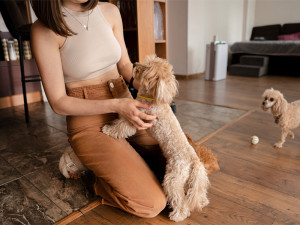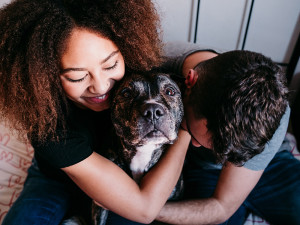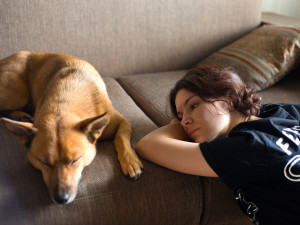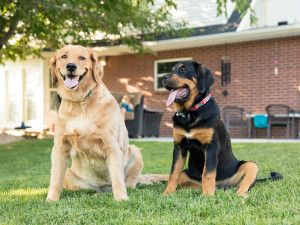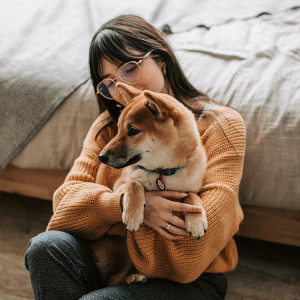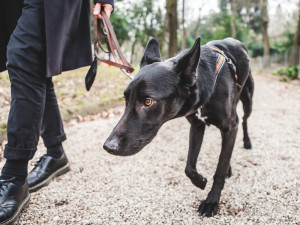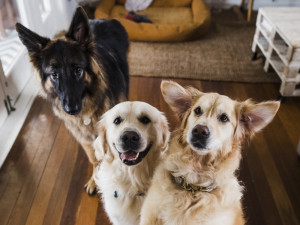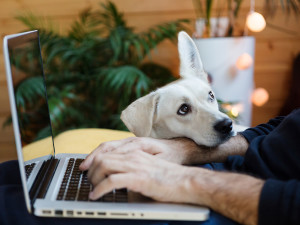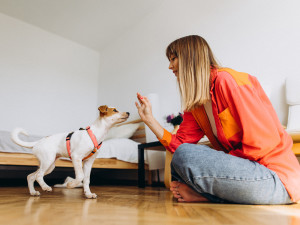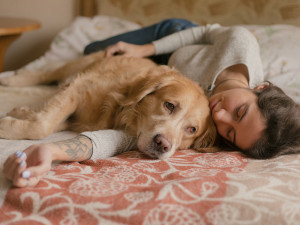Why Does My Dog Follow Me Everywhere?
They are the cutest little shadow.
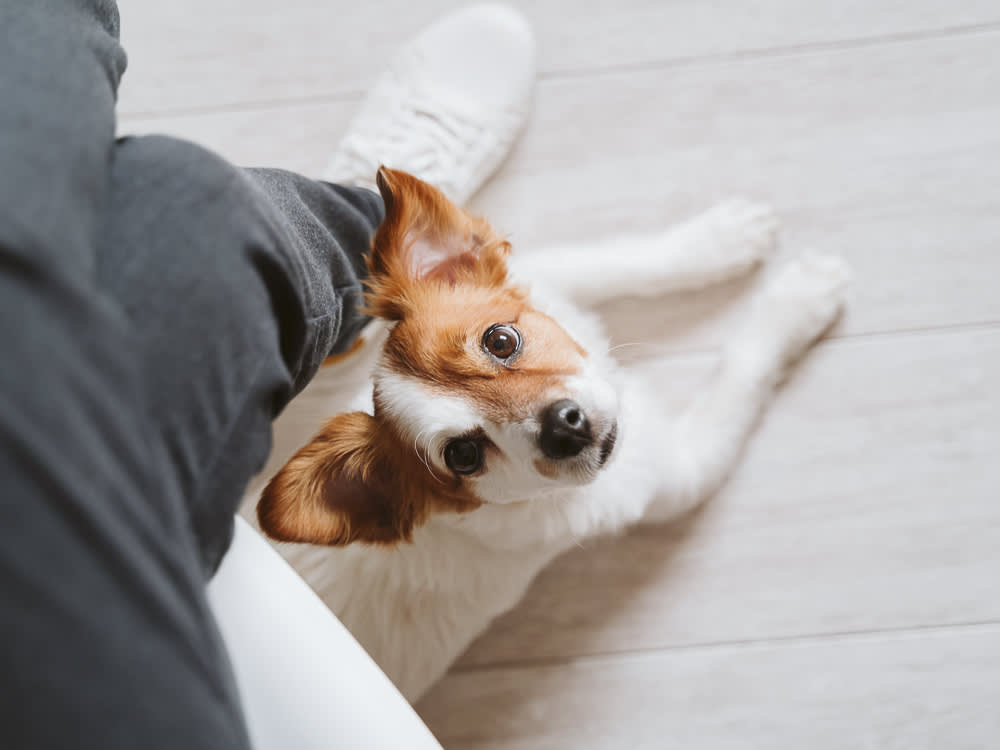
share article
In This Article:
Reasons Dogs Follow Their Pet Parentsopens in a new tab Should I Worry If My Dog Follows Me All The Time?opens in a new tab How Can I Get My Dog to Stop Following Me Everywhere?opens in a new tab Puppy vs. Adult Dog Following Habitsopens in a new tab Frequently Asked Questionsopens in a new tab
Into the bathroom. Under the covers. Where hasn’t your pup followed you? Dogs are naturally social and tend to like to be around their people, which is why we’re not surprised when they seek out our company.
Yet, so many dogs follow us consistently and with such enthusiasm the term “Velcro Dog” is readily understood. The familiar experience of our dogs scampering along with us no matter how mundane the reason for our movement (“Buddy, I’m just going to get my charger!”) raises the question, “Why does my dog follow me?”
Reasons dogs follow their pet parents
Generally speaking, when a dog follows you, it means they just want to be around you (relatable, because you don’t want to leave their side, either!). Dogs are (newsflash!) naturally social animals who crave companionship and security, which they seek and receive from us. They form strong bonds with their pet parents and stay close for emotional support. Perhaps the real question is why they want to be around us … and so close!
Here are a few reasons dogs want to be around us so much they follow us wherever we go.
1. Companionship
As mentioned, dogs are social. They form bondsopens in a new tab quickly and deeply with the people in their lives, and they tend to want to stick close to those people. Dogs who constantly follow their humans are displaying their sociability and emotional connection.
2. Attention
Dogs want our attention. If we move, they follow, perhaps in the hope that their motion will attract our attention. Even the most loved and cared-for dogs who have lots of daily activities will spend a certain amount of time waiting for the next interesting thing to happen. When we get moving, they presumably view our actions as a sign that the attention they seek is about to be bestowed upon them.
3. Hunger
Food! Sometimes we move when we’re getting ready to feed them (and ourselves). Therefore, many dogs trot along in eager anticipation of getting a meal, or at least a snackopens in a new tab or a little handout.
4. Interest in a walk
Dogs are generally eager to be on the move, so when we’re in motion, they join us. Of course, just walking around the house isn’t their favorite way to get going. Many dogs seem ever-hopeful that when we get up, we’ll head outside for a real walk with them. This is especially true if we head in the direction of the leashopens in a new tab or the door.
5. Worry about being left behind
Many dogs associate our movement with departures. When we head to the garage, the car, or the front door, our dogs may follow along to monitor the situation, seemingly checking to reassure themselves that we’re not leaving or that if we are, they’ll be going, too.
6. Anxiety
Frequently, dogs who are unable to cope with being left alone opens in a new tabcan’t bear to have us out of their sight. If we leave, they experience a form of panic. Because they’re unable to tolerate being alone, they follow us to be in our constant company and to avoid any separation at all.
7. Boredom
One reason why a dog would follow you, even if you’re just going to the bathroom, is boredom. Following us gives them something to do. So many dogs are looking for stimulation of any sort — gamesopens in a new tab, food puzzles,opens in a new tab walksopens in a new tab, trainingopens in a new tab … more of anything that fills their days with joy. Perhaps it’s more interesting to accompany us than just to lie there and watch us.
8. Anticipation
Reinforcement drives behavior, and good things have happened when they’ve followed us in the past — a play session, an outing, a training session or maybe just some petting. If the relationship is a good oneopens in a new tab, our dogs associate being around us with feeling happy. Many dogs follow their humans because experience has taught them good things happen when they do.
9. Feeling unwell
Dogs who are feeling sick or experiencing painopens in a new tab often want to be near us for security or to seek help. When something is bothering them because they are sick or injured, it’s common for dogs to stick by us no matter where we go, even if that means constantly following us around.
10. Thunderstorms
Some dogs are more clingy when they are uncomfortable about something, and one common cause of feeling uncomfortableopens in a new tab is a thunderstorm. If your dog is usually a little more independent but is glued to you during storms, you’ve probably noticed the pattern. However, some dogs begin to follow us when the storm is on its way but has not yet arrived.
Many dogs begin to feel uneasy when the wind picks up or when the barometric pressure changes. The reason is a little harder to figure out if that’s the case because a thunderstorm doesn’t happen every time it’s windy or the pressure drops.
Should I worry if my dog follows me all the time?
A dog who follows you around is not necessarily cause for concern. However, in some situations, that worry is warranted. For example, if your dog can’t handle you being in another room even briefly without freaking out, they may need help to improve their quality of life and wellbeing.
Similarly, if you’re the only one they only pay attention to and they either act terrified of other people or act as if these other people don’t exist, they may need help to expand their social circle. And if they are following you around out of boredom, that should worry you enough to add play, training, exercise, games or other enrichment to their daily experience so their life is more fulfilling.
How do I know if my dog has separation anxiety?
Dogs with separation anxietyopens in a new tab show a variety of behavioral and physiological responses to being left alone or even to signs that their pet parent is preparing to leave. Such responses include following behavior, drooling, peeing and pooping in the house, salivating, destructive chewing, scratching at doors and windows, howling, barking, whining, pacing, and escaping the house.
It can be hard to know if a dog has separation anxiety or not because so many of these occur in dogs without separation anxiety. It’s essential to consult with a veterinarian for a diagnosis because separation anxiety is a medical condition with similarities to panic disorders in people.
Generally speaking, dogs who display symptoms as their pet parent is getting ready to leave or within the first minutes after the departure are more likely to have separation anxiety than those who only show the above signs after hours of being alone. Boredom that leads to scratching, chewing, and vocalizing, or just really needing to pee and poop because of a medical condition or because it’s been a while can lead to the same symptoms seen in separation anxiety, so there is plenty of room for confusion.
How can I get my dog to stop following me everywhere?
No matter how much you love your dog, having them as your constant shadow can be a challenge. It can make you feel guilty, it can affect your productivity, and it can lead to tripping and falling. (It’s happened to me, it’s happened to you, it’s happened to everyone and let’s stop pretending otherwise!) To keep everyone happy and safe, there are things you can do if you’ve ever been lying on the floor after a spill wondering, “Can someone please tell me how to get my dog to stop following me?” or asking that question at any other time.
It can help to keep them engaged in stimulating activities, so lots of food puzzles, things to chew on, and toys are helpful. Make sure they get enough exercise so it’s easier for them to settle because that can help, too. Train them to stay on cue and reinforce them for doing so. Training gives them practice remaining where they are even when you move around and makes it a positive experience for them.
Provide opportunities for them to be away from you for short periods of time with something fun to do to increase their level of comfort in your absence. It’s good to know how to stop a dog from following you around because doing so often leads to a happier dog.
Puppy versus adult dog following habits
Dogs of any age may follow people around, but there are many individuals who follow people around constantly as puppies, but do so far less as they get older. It’s natural for puppies to stick close to others whether it’s their mom and littermates, another dog in your home, or you.
Following behavior is extremely common in young puppies, and most dogs decrease this behavior gradually as they enter adolescence and then become adults. Many adult dogs who follow people constantly are likely to become upset to some degree if they are prevented from being with us. However, in puppies, it’s often just a simple case of them wanting to be near us, but being perfectly capable of coping with short separations.
FAQs (People also ask):
Why does my female dog follow me around?
Generally male and female dogs are equally likely to follow you around, but female dogs in heat are especially likely to stick close to you and follow you wherever you go.
Are there breeds that are more independent than others?
Dogs who are bred to work closely with people such as herding, retrieving, and cooperative hunting dogs are generally less independent than dogs who were bred to work on their own such as terriers and guard dogs.
Why does my dog follow me to the bathroom?
It’s a mystery, but various theories are they are guarding us like we watch over them when they go to the bathroom, they like the smells, and they follow us because we close the bathroom door and they want to be on the same side.
Why does my dog follow me and not my spouse?
They may be more bonded to you. You may be more attentive, at home more, play with them more often, or smell more appealing. The dog may like the treats you offer or your petting style. The dog may be intimidated by your spouse.

Karen B. London, PhD, CAAB, CPDT-KA
Karen B. London, Ph.D., is a Certified Applied Animal Behaviorist and Certified Professional Dog Trainer who specializes in working with dogs with serious behavioral issues, including aggression, and has also trained other animals including cats, birds, snakes, and insects. She writes the animal column for the Arizona Daily Sun and is an Adjunct Professor in the Department of Biological Sciences at Northern Arizona University. She is the author of six books about training and behavior, including her most recent, Treat Everyone Like a Dog: How a Dog Trainer’s World View Can Improve Your Lifeopens in a new tab.
Related articles
![A woman wearing a knit sweater holding a dog close on the floor of her bedroom.]() opens in a new tab
opens in a new tabSeparation Anxiety in Dogs
Train your dog to stay calm when they’re on their own — instead of sad-singing “All By Myself” until you come home.
![Shy black dog walking with owner at the park.]() opens in a new tab
opens in a new tabHow to Help an Anxious Dog Conquer Their Fears
Pro tips for boosting the confidence of a scaredy-cat dog.
![3 dogs posed together in a house]() opens in a new tab
opens in a new tabDoes Your Dog Have a Unique Personality?
Yep, research says your dog is as special and perfect as you tell them they are.
![Dog Seeking Attention Owner Working On Laptop.]() opens in a new tab
opens in a new tabWhy Is My Dog Being Clingy?
Your dog’s Velcro habits are cute—but not always convenient.
![A beautiful trained cute puppy obediently obeys the commands of its female owner at home.]() opens in a new tab
opens in a new tab5 Important Puppy Behavioral Milestones to Keep Track Of
Your little cutie is growing up in many ways—look out for these big stages as they do.
- opens in a new tab
Does Your Dog Need Anti-Anxiety Meds?
How to cope with dog anxiety—from training to medication.
